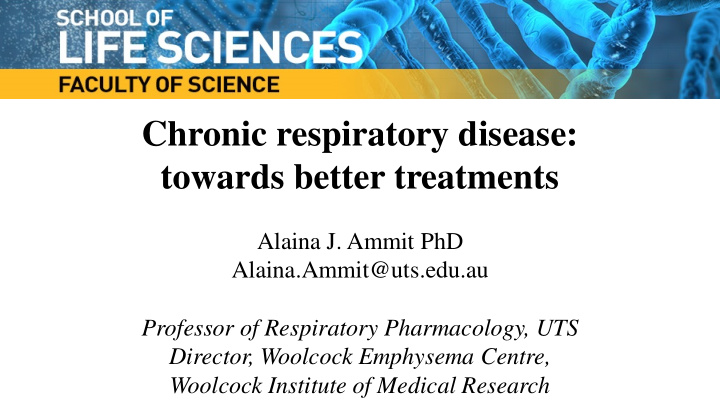



Chronic respiratory disease: towards better treatments Alaina J. Ammit PhD Alaina.Ammit@uts.edu.au Professor of Respiratory Pharmacology, UTS Director, Woolcock Emphysema Centre, Woolcock Institute of Medical Research
Chronic respiratory disease • Asthma – 1 in 10 Australians have asthma – More common in males aged 0–14, but among those aged 15 and over, asthma is more common in females • Chronic Obstructive Pulmonary Disease (COPD) – In Australia, COPD ranks third behind ischaemic heart disease and stroke as a major cause of disability and early death – 1 in 7 Australians over the age of 40 are affected by COPD – By 2020, COPD is projected to become the third most important chronic illness in the world Asthma Australia; Australian Institute of Health and Welfare
Asthma and airway remodelling • Acute asthma – bronchoconstriction and difficulty breathing • Asthma is a chronic inflammatory condition of the lung associated with structural remodelling, or thickening, of the airway wall – Mucus hypersecretion – Neovascularization – Airway fibrosis – Increased airway smooth muscle mass
Non-asthmatic airway Asthmatic airway
COPD • Chronic inflammatory disease characterised by progressive lung function decline • Main symptoms are breathlessness , cough and sputum production • Major public health problem worldwide • Globally, the burden of COPD is projected to increase due to continued exposure to COPD risk factors: – tobacco smoke, outdoor air pollution and indoor noxious particles and gases from cooking and heating fires • Prevalence, morbidity and mortality of COPD are increasing in many westernised countries and cigarette smoking is the main cause
COPD: lung function decline Chronic inflammation in the lungs of people with COPD drives damage and long-term decline in lung function ( breathlessness ). Current COPD medications don’t slow the accelerated rate of decline
GOAL Target molecular mechanisms to treat chronic respiratory diseases But wait… don’t we have drugs for that already? YES
BUT… they are not always effective… • Anti-inflammatory corticosteroids and bronchodilatory β 2 -agonists are first line therapy • Although these medicines have proven clinical efficacy, many respiratory conditions are not responsive: – severe asthma, COPD, infectious exacerbation • We urgently require improved and novel ways to treat chronic respiratory disease when current medicines are ineffective • Need greater understanding of molecular mechanisms • This is what my research team does...
What are the current issues limiting treatment today? β 2 -adrenergic receptor desensitization >5 recent publications in the top respiratory journals (in collaboration with Brian Oliver)
What are the current issues limiting treatment today? Cannot repress inflammation in severe asthma and COPD Current project as an example of our capabilities for potential funding and collaboration with industry partners
Harness the power of endogenous anti- inflammatory proteins in COPD TTP (tristetraprolin) A molecular switch
TTP Tristetraprolin (TTP), a destabilising RNA binding protein, is a critical anti-inflammatory protein that induces the decay of mRNAs encoding several cytokines, including those that drive COPD pathogenesis IL-6, IL-8, IL-2, GM- CSF, GRO- α , TNF α TTP Inflammation in COPD TTP is a molecular switch and is likely turned off under respiratory disease conditions
GOAL Switch TTP on to turn off inflammatory in COPD HOW?
We can switch TTP on by activating PP2A We can repress inflammation when current medicines (corticosteroids) cannot
GOAL more effectively Target inflammatory mechanisms to treat inflammation and reduce lung function ^ decline in COPD The development of novel PP2A pharmacotherapeutic activators anti-inflammatory strategies
Recommend
More recommend